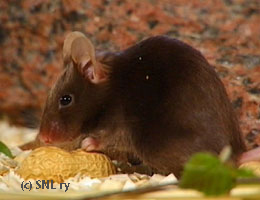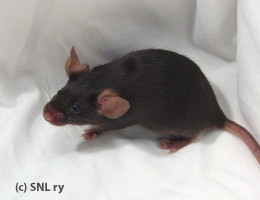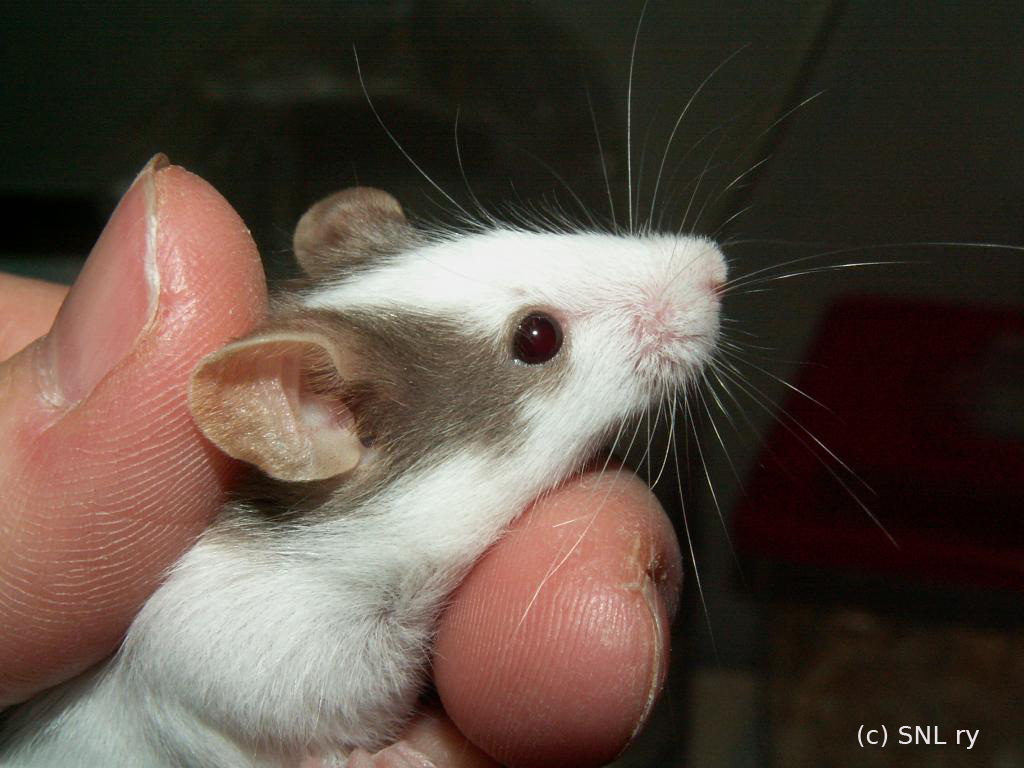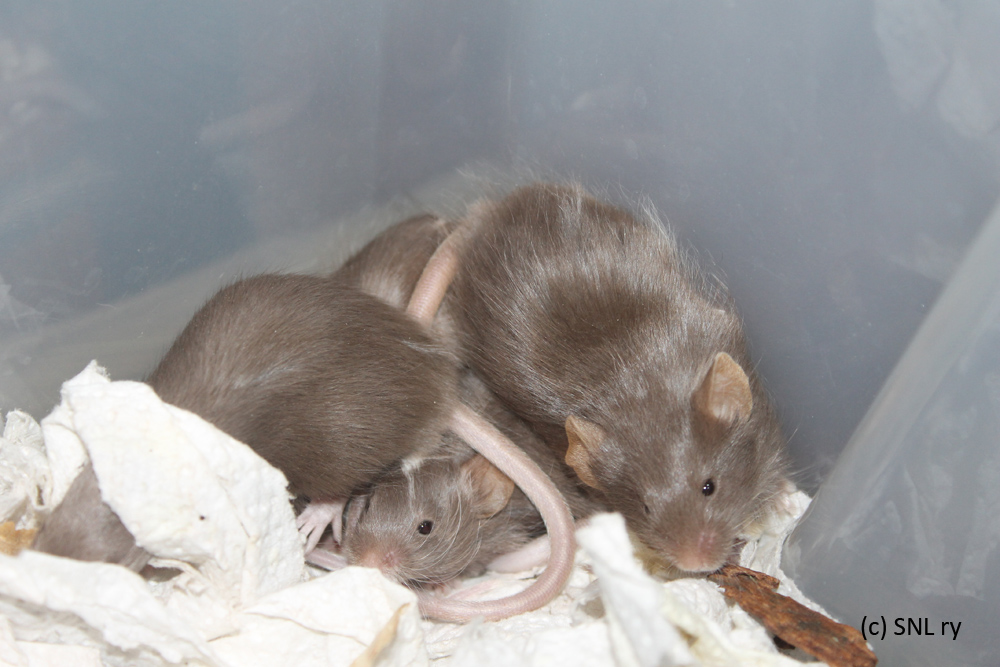Varieties
I - Self
Chocolate (cc)
a/a bc/bc D/* C/* P/* or
a/a bc/b D/* C/* P/*
"The colour should be that of plain (not milk) chocolate and should be rich, deep and full of life. Eye black."
Breeding information below the pictures.
Quick Look
The desired shade in chocolates is rich, lively plain chocolate, not milk chocolate. The chocolate has the potential of having a good size and type, as there is no "retarding" black genetic factor to hold them back in this.
Common faults include: too light colour, colour lacking warmth; light ears, feet, nails and tail; tan vents and throat spots; tan hairs along the sides.
Genetic Background
Genetically speaking, Chocolate is a cordovan dilution of black: a/a bc/* D/* C/* P/*.
The official name of the gene (in genetic parlance allele) that makes a mouse chocolate instead of black is "cordovan" and it is a spontaneous recessive mutation of tyrosinase-related protein 1. The official geneticist's symbol is Tyrp1b-c. It is located in chromosome 4. Cordovan is fully recessive to B and fully dominant over b. Hence the bc/*.
The colour of the mouse is changed from black to rich deep brown due to an actual change in the colour of the pigment, as well as in the size and shape of the pigment granules. The pigment granules become smaller and are more uniform in size than black pigment granules. Their shape becomes round, instead of oval. Brown animals have about a third of the intensity of pigment than black animals. However, chocolate mice have more tyrosinase than black mice.
Many, if not actually most, sites listing mouse colour genotypes give the genotype of chocolate as a/a b/b D/* C/* P/*. This is, in fact, quite misleading as you can't get the chocolate called for in most standards with the "plain old b". More on this gene later.
In More Practical Terms?
The goal of a chocolate breeder is to get a line of beautiful mice, with a delicious chocolate colour that is neither too light to become plain, nor too dark to lose warmth, with well pigmented extremities and without any tan or white hairs whatsoever. In a nutshell: chocolate mice that look so good you're tempted to take a taste.
A good chocolate mouse is easily ruined colourwise, if it sports light extremities (ears, feet, nails, tail), so eliminating these faults is of prime importance. It should go without saying, that the breeder should not use even a splendidly coloured chocolate who has a tail tip or any other extra white marks on her body. The problem brought on by tan hairs along the flanks and on the vent does not show as well on a chocolate as it does on a black, but that isn't a good enough excuse to neglect trying to breed them out.
Running a successful line of chocolates and reds would be quite possible. Red mice with chocolate background (Ay/a bc/* D/* C/* P/*) can look quite good, with a rich red colouring and a good red does not have any qualities that would make a chocolate any way lacking. Of course, a successful line of chocolates and reds would require the chocolates to be devoid of umbrous-determinants, as chocolates with U would make the reds throw chocolate sables - or sooty reds. On a chocolate mouse U can make the mouse somewhat darker in colour, especially on the back, which can show up as "muddied" colour.
For an outcross, an occasional good black thrown in can help keeping the shade dark. This particular outcross sets the breeder back a generation or two, as the first generation will be black (unless the mouse used for the outcross carries chocolate) and only the next generation brings chocolate along with some more black mice when mated to a chocolate. However, a good black carries a risk called umbrous. Most good black mice tend to carry - or rather, have - the umbrous determinant, which of course does not really show. However, it can be passed on to the next generation and show on a chocolate as "muddy" colouring.
It should be noted, that while the extreme non-agouti gene ae gets you stunning black mice, ae/ ae bc/* D/* C/* P/* may not give you the colour called for in the standards. Yes, the colour will be dark. Yes, the problem of tan hairs is eradicated. Yes, the extremities will be splendidly pigmented. But the colour also tends to lack redness-related warm shade due to ae's effect.
While crossing cinnamon with chocolate isn't as problematic as crossing agouti with black, the same causes for caution stand. cinnamons tend to have lesser problems with being umbrous than agoutis do, but cinnamon to chocolate crosses can add to the problem of the chocolates having tan hairs along the flanks and at the vent.
The pink-eyed version of chocolate, champagne, might sound like a suitable combination, but in fact poses problems for chocolate (and champagne). First of all, chocolate is expected to be dark, champagne is a delicate, light shade so you'd have to tackle contrasting modifiers.
Second, a lot of good show champagnes are actually genetically pink-eyed lilacs so you'd get your lines throwing not only pink eyes, also lilacs along the way.
Third, champagnes tend to lighten the extremities of chocolates. Fourth, champagnes can be b/b instead of bc/*, giving you too light "milk chocolates" and fifth - if you still need another reason - the brown dilution gene b is a dominance modifier of P, which means that a/a b/b P/p mice are lighter than a/a b/b P/P. Now, my sources do not say out right that bc has the same effect on P, but it is a risk worth keeping an eye out for.
Lilac, the blue dilution of chocolate, would bring in unwanted blue dilution and unless your ultimate goal is to give yourself a headache with trying to breed winning Lilacs, mixing blue dilution into your line of chocolates is not that bright an idea.
Along with above mentioned champagne, other pink eyed varieties pose their share of problems, not only with bringing unwanted dominants (with dove and dove tan), unwanted recessives (with silver and silver tan as well as show-quality champagne) in addition to introducing the pink-eyed gene p to the lines.
Pink Eyed White is anything but a safe outcross. A true albino is seldom a chocolate "under the albinism", so a chocolate x PEW cross can bring on all kinds of unwanted results. It pays to remember, that you simply can not see white tail tips or other similar faults a PEW may have - but even unseen faults can be passed on to the young.
Although all genetically albino (c/c) mice are Pink Eyed Whites in colour, not all PEWs are necessarily genetically albinos. Combining a non-albino PEW with a chocolate can result in very odd results indeed. It does not pay to take that risk.
Along with PEWs, all other c-locus recessive colours are definitely out of the question as an outcross to chocolate. Do trust me on this one, chocolate to c-locus recessive colour is a Bad Idea. The cross would do no good to the chocolate and adding chocolate to the c-locus recessive colours does not make them any good. At all. For example, with pointed varieties, you'd just get non-standardized (and they usually aren't for a good reason - they don't look that distinct to deserve their own standards) chocolate dilutions of the varieties in question down the line.
OK, there's one exception to the rule above: coffee. Even that one includes the same caveats as beige to black.
What About b?
Brown dilution, b, is an old mutation. Brown mice have been long seen within pet (and fancy) mice and the colour does make an appearance in late 19th century mouse fancier's manual.
The official name of brown dilution gene (allele) is "brown" and the official symbol is Tyrp1b. It turns the eumelanin of both the hairs and the eyes brown instead of black. That is, the eyes of b/b mice is not black, although they can seem to be black. In a good light and especially on photographs taken with flash, the eyes of a b/b mouse look ruby. b is fully recessive to bc.
The colour b/b produces can be read from the standards of chocolate, it's there in the parentheses: "not milk". That is to say, the colour is plain, milk chocolate kind of colour, lacking depth and redness. Cinnamons with b/b instead of bc/* have the same problems when it comes to colour than b/b "chocolates".
Even though b/b produces poor chocolate colour and isn't truly useful in any of the mouse varieties, the gene is still around. Mostly, it can be found in pet mice, in spotted varieties - and in some c-locus recessive varieties, like bone, beige and even the pointed varieties.
Chocolate Look-alikes?
Chinchillated chocolate (a/a bc/* cch/ cch), dark coffee (a/a bc/* ce/ ce) and burmese with weak points (a/a B/* cch/ch / a/a bc/* cch/ch) can all pass as chocolates rather convincingly. You can tell these look-alikes apart from the real things by checking for tan hairs. If those hairs are tan, it's a chocolate. If they are white or silver, it's a look-alike.
Starting From Scratch?
If there are no chocolates to start with, look for good a good chocolate tan and mate it to black. You'll need to "clean out" the tan and the B, but this route is most likely to give you a starting point that's worth something.







